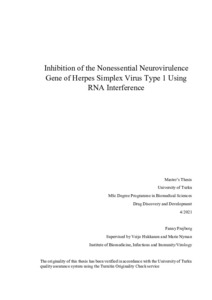Inhibition of the Nonessential Neurovirulence Gene of Herpes Simplex Virus Type 1 Using RNA Interference
Frejborg, Fanny (2021-05-04)
Inhibition of the Nonessential Neurovirulence Gene of Herpes Simplex Virus Type 1 Using RNA Interference
Frejborg, Fanny
(04.05.2021)
Julkaisu on tekijänoikeussäännösten alainen. Teosta voi lukea ja tulostaa henkilökohtaista käyttöä varten. Käyttö kaupallisiin tarkoituksiin on kielletty.
avoin
Julkaisun pysyvä osoite on:
https://urn.fi/URN:NBN:fi-fe2021060232841
https://urn.fi/URN:NBN:fi-fe2021060232841
Tiivistelmä
Herpes simplex virus type 1 (HSV-1) is a common pathogen that causes recurrent and latent infections in humans. The nonessential neurovirulence gene γ134.5 prevents cellular responses to an infection in differentiated host cells. The deletion of this gene makes HSV-1 conditionally replicative. Thereby most of the HSV-1 vectors and oncolytic viruses carry this deletion. The objective of this study was to assess whether targeting γ134.5 using RNA interference would be antiviral or gene-specific. The effects of six siRNAs targeting γ134.5 were studied in vitro. The cellular viability, antiviral efficacy, γ134.5 gene expression, and host responses were assessed. Three cell lines were used – U373MG representing neuronal cells, HCE representing epithelial cells, and Vero cells (non-human primate kidney). The viruses used were the recombinant wild type-like HSV-1(17+)LoxPmCMVGFP and the HSV vector backbone H1052. The γ134.5 siRNAs were well tolerated in U373MG and HCE cells. The γ134.5 gene expression of the wild type–like virus was inhibited in U373MG cells. Some γ134.5 siRNA treatments induced a reduction in viral shedding whilst others an increase. This was correlated with the innate immunity, where the samples with an increase in viral shedding had a reduction in cellular responses. The successful inhibition of γ134.5 in U373MG cells shown in this study could be further developed into a new method for vector production and selection in vitro, or to new in vivo infection models with protection from severe infections, when using wild type-like viruses.
